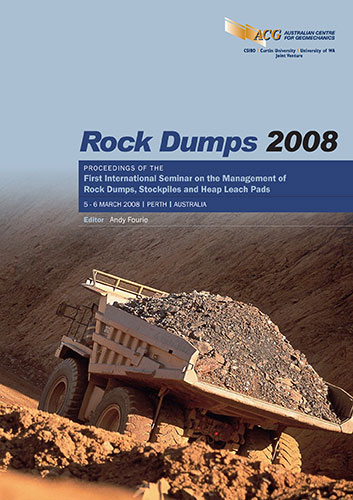Design and Performance of Paste Rock Systems for Improved Mine Waste Management

|
Authors: Wilson, GW; Wickland, B; Miskolczi, J |
DOI https://doi.org/10.36487/ACG_repo/802_9
Cite As:
Wilson, GW, Wickland, B & Miskolczi, J 2008, 'Design and Performance of Paste Rock Systems for Improved Mine Waste Management', in AB Fourie (ed.), Rock Dumps 2008: Proceedings of the First International Seminar on the Management of Rock Dumps, Stockpiles and Heap Leach Pads, Australian Centre for Geomechanics, Perth, pp. 107-116, https://doi.org/10.36487/ACG_repo/802_9
Abstract:
Waste rock and tailings can be blended to produce an engineered material with superior physical and hydraulic properties for the construction of post mining landforms. The new material, termed paste rock has a low hydraulic conductivity, high water retention capacity (air entry value), high strength and low compressibility. These properties can be used to restrict oxygen entry and water seepage into mine waste deposits for minimising oxidation and metal leaching within sulphide bearing materials. The new material also has a density much higher than either conventional tailings or waste rock deposits, thereby reducing the total volume of waste and creating opportunities to reduce surface area requirements for impoundment design and construction. Laboratory testing, meso-scale experiments and field scale trials using selected blends of waste rock and tailings were constructed between 2000 and 2007 at the Porgera mine, PNG and the Copper Cliff mine, Canada. Results show that hydraulic conductivity values for paste rock mixtures comparable to consolidated paste tailings (i.e. 10-7 m/sec to 10-8 m/sec) with volume change characteristics similar to waste rock can be achieved. In addition, field scale lysimeter measurements demonstrate infiltration and drainage rates are reduced by almost 2 orders of magnitude when paste rock is used to construct cover systems on tailings. The present paper summarises the key findings for the seven year study and describes implementation of the new technology into mine waste practice.
References:
Fines, P., Wilson, G.W., Landriault, D., Lanteigne, L. and Hulett, L. (2002) Co-Mixing of Tailings Waste Rock and
Slag to Produce Barrier Cover Systems. Proceedings 6th International Conference on Acid Rock Drainage,
Cairns, Australia.
Herasymuik, G.M. (1996) Hydrology of a Sulphide Waste Rock Dump. MSc Thesis, University of Saskatchewan,
Saskatoon, Canada.
Miskolczi, J. (2007) Performance Evaluation of Cover Systems Constructed of Paste Rock Material. MSc Thesis,
University of British Columbia, Vancouver, Canada.
Wickland, B. (2006) Volume Change and Permeability of Mixtures of Waste Rock and Fine tailings. PhD Thesis,
University of British Columbia, Canada.
Wilson, J.A., Wilson, G.W. and Fredlund, D.G. (2000) Numerical modelling of vertical and inclined waste rock layers.
Proceedings Fifth International Conference on Acid Rock Drainage, May 21-24, Denver, USA, pp. 257-266
(Society for Mining, Metallurgy, and Exploration Inc: Littleton, Colorado).
Design and Performance of Paste Rock Systems for Improved Mine Waste Management G.W. Wilson, et al.
116 Rock Dumps 2008, Perth, Australia
© Copyright 2025, Australian Centre for Geomechanics (ACG), The University of Western Australia. All rights reserved.
View copyright/legal information
Please direct any queries or error reports to repository-acg@uwa.edu.au
View copyright/legal information
Please direct any queries or error reports to repository-acg@uwa.edu.au